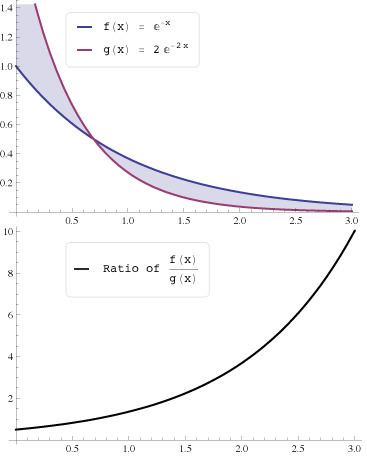 | ||
In statistics, the monotone likelihood ratio property is a property of the ratio of two probability density functions (PDFs). Formally, distributions ƒ(x) and g(x) bear the property if
Contents
- Intuition
- Example Working hard or slacking off
- Families of distributions satisfying MLR
- Hypothesis testing
- Example Effort and output
- Relation to other statistical properties
- Exponential families
- Most powerful tests The KarlinRubin theorem
- Median unbiased estimation
- Lifetime analysis Survival analysis and reliability
- Proofs
- First order stochastic dominance
- Monotone hazard rate
- Economics
- References
that is, if the ratio is nondecreasing in the argument
If the functions are first-differentiable, the property may sometimes be stated
For two distributions that satisfy the definition with respect to some argument x, we say they "have the MLRP in x." For a family of distributions that all satisfy the definition with respect to some statistic T(X), we say they "have the MLR in T(X)."
Intuition
The MLRP is used to represent a data-generating process that enjoys a straightforward relationship between the magnitude of some observed variable and the distribution it draws from. If
Example: Working hard or slacking off
Suppose you are working on a project, and you can either work hard or slack off. Call your choice of effort
- Choose effort
e ∈ { H , L } where H means high, L means low - Observe
q drawn fromf ( q ∣ e ) . By Bayes' law with a uniform prior,P r [ e = H ∣ q ] = f ( q ∣ H ) f ( q ∣ H ) + f ( q ∣ L ) - Suppose
f ( q ∣ e ) satisfies the MLRP. Rearranging, the probability the worker worked hard is
Families of distributions satisfying MLR
Statistical models often assume that data are generated by a distribution from some family of distributions and seek to determine that distribution. This task is simplified if the family has the Monotone Likelihood Ratio Property (MLRP).
A family of density functions
Then we say the family of distributions "has MLR in
Hypothesis testing
If the family of random variables has the MLRP in
Example: Effort and output
Example: Let
Relation to other statistical properties
Monotone likelihoods are used in several areas of statistical theory, including point estimation and hypothesis testing, as well as in probability models.
Exponential families
One-parameter exponential-families have monotone likelihood-functions. In particular, the one-dimensional exponential-family of probability density functions or probability mass functions with
has a monotone non-decreasing likelihood ratio in the sufficient statistic T(x), provided that
Most powerful tests: The Karlin–Rubin theorem
Monotone likelihood-functions are used to construct uniformly most powerful tests, according to the Karlin–Rubin theorem. Consider a scalar measurement having a probability density function parameterized by a scalar parameter θ, and define the likelihood ratio
is the UMP test of size α for testing
Note that exactly the same test is also UMP for testing
Median unbiased estimation
Monotone likelihood-functions are used to construct median-unbiased estimators, using methods specified by Johann Pfanzagl and others. One such procedure is an analogue of the Rao--Blackwell procedure for mean-unbiased estimators: The procedure holds for a smaller class of probability distributions than does the Rao--Blackwell procedure for mean-unbiased estimation but for a larger class of loss functions.
Lifetime analysis: Survival analysis and reliability
If a family of distributions
- the family has monotone decreasing hazard rates in
θ (but not necessarily inT ( X ) ) - the family exhibits the first-order (and hence second-order) stochastic dominance in
x , and the best Bayesian update ofθ is increasing inT ( X ) .
But not conversely: neither monotone hazard rates nor stochastic dominance imply the MLRP.
Proofs
Let distribution family
or equivalently:
Integrating this expression twice, we obtain:
First-order stochastic dominance
Combine the two inequalities above to get first-order dominance:
Monotone hazard rate
Use only the second inequality above to get a monotone hazard rate:
Economics
The MLR is an important condition on the type distribution of agents in mechanism design. Most solutions to mechanism design models assume a type distribution to satisfy the MLR to take advantage of a common solution method.
